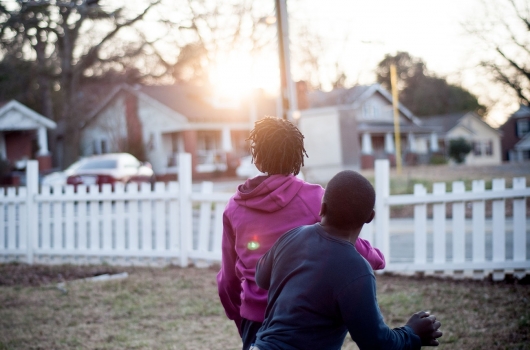Hallowed Placemaking: Part 2
 Photo credit: Lesley Ann Tommey
Photo credit: Lesley Ann Tommey
In part 1 of this series, Helms Jarrell, of QC Family Tree, proposed the idea of Hallowed Placemaking – a place-based practice of casting the vision, manifesting the reality we are hoping for. Hallowed Placemaking is the practice of making real our prayer, “on earth as it is in heaven.” She further challenged us to consider creating Beloved Community prototypes using the resources we have as medium and our places as a canvas. In part 2 of the Hallowed Placemaking series, Helms explores issues of displacement, development, and a place-based practice of resurrection.
In his book Where the Water Goes Around, Bill Wylie-Kellermann writes about reimagining place-based communities of faith. In one passage, Wylie-Kellermann describes publicly walking the stations of the cross in his neighborhood. His community of faith carries a cross through their Detroit neighborhood and downtown. They stop for meditation at specific sites. This practice is a way for them to mark with their bodies, as well as their prayers, where Christ is being crucified today.
Wylie-Kellermann identifies this practice as “creating a liturgy of place.” He writes,
“Each year the landscape we walk has changed to one degree or another. Ground shifts beneath our feet. Spaces open and fill with new cries. Buildings disappear or spring up before us. The faces of victims and executioners rise up to us from a particular historical moment in a particular place, both our own.”
The kind of Hallowed Placemaking that Wylie-Kellermann describes reminds me of Walter Brueggemann’s concept of prophetic imagination,
“a concrete practice that is undertaken by real believers who share the conviction of grief and hope that escapes the restraints of dominant culture.”
I recently interviewed Chris Lawrence, pastor of Church of the Living Hope in Harlem NYC, for the Here for Good podcast. Chris talks about dedicating his attention to a very small radius and intentionally nurturing relationship and connection in that particular place. In East Harlem, Hallowed Placemaking looks like a community gathered at a coffee shop to crochet large flowers to display on chain link fences, a block party for the purpose of revitalizing an unused space into a garden, and front stoop tea conversations with the elderly. In East Harlem, Hallowed Placemaking is a practice of resurrection, bringing a place alive with art, music, and relationship. What Chris Lawrence terms “re-neighboring,” others might call “remembering.”
In Harlem, as with most cities in the country, communities are undergoing drastic amounts of change. The rise of development is changing neighborhoods very quickly. Residents of more vulnerable neighborhoods are being displaced at high and frequent rates. People who have invested their lives, time, and relationships in a particular place are losing not only their house, but their culture, proximity to family, and their networks of support. What can we do to practice resurrection in such a climate?
Church of the Living hope has big dreams of creating cooperatively owned housing in East Harlem. The vision involves creating a network of linked apartments, cooperatively purchased, to house residents who would like to stay in place and engage in community building. By opting for communal space, residents would share housing costs. The co-op housing space would be a hub for community building run by residents.
QC Family Tree, where I serve, is addressing loss of homes and loss of connection in a number of ways. A collective of West Side neighbors in Charlotte, including QCFT residents, have formed the West Side Community Land Trust. WSCLT is a nonprofit seeking to create and preserve permanently affordable housing as well as preserve the social fabric of neighborhoods. In addition to working with the land trust, QCFT offers affordable housing to five families and it is in the process of raising the funds to purchase another home for affordable housing as well. QCFT continues to offer opportunities for community members, to gathering socially for meals, art workshops, Bible Study, and other cultural enrichment activities.
Hallowed Placemaking becomes incarnate in a lot of different ways. Even when the place where we call home shifts beneath our feet, practicing resurrection is possible. It takes place when we, hope filled and steadfast, reimagine the possibilities and collectively utilize our resources to keep people in place and connected.
Printer-friendly version here! >>
The NBA incubates new ministries, supporting social entrepreneurs of faith who are serving their communities in a variety of innovative ways and empowering these Disciples-led health and social service projects to focus on growth, impact, and sustainability. Learn more at nbacares.org/incubate or by contacting Rev. Ayanna Johnson Watkins, Director of the NBA Incubate Initiative, at awatkins@nbacares.org.